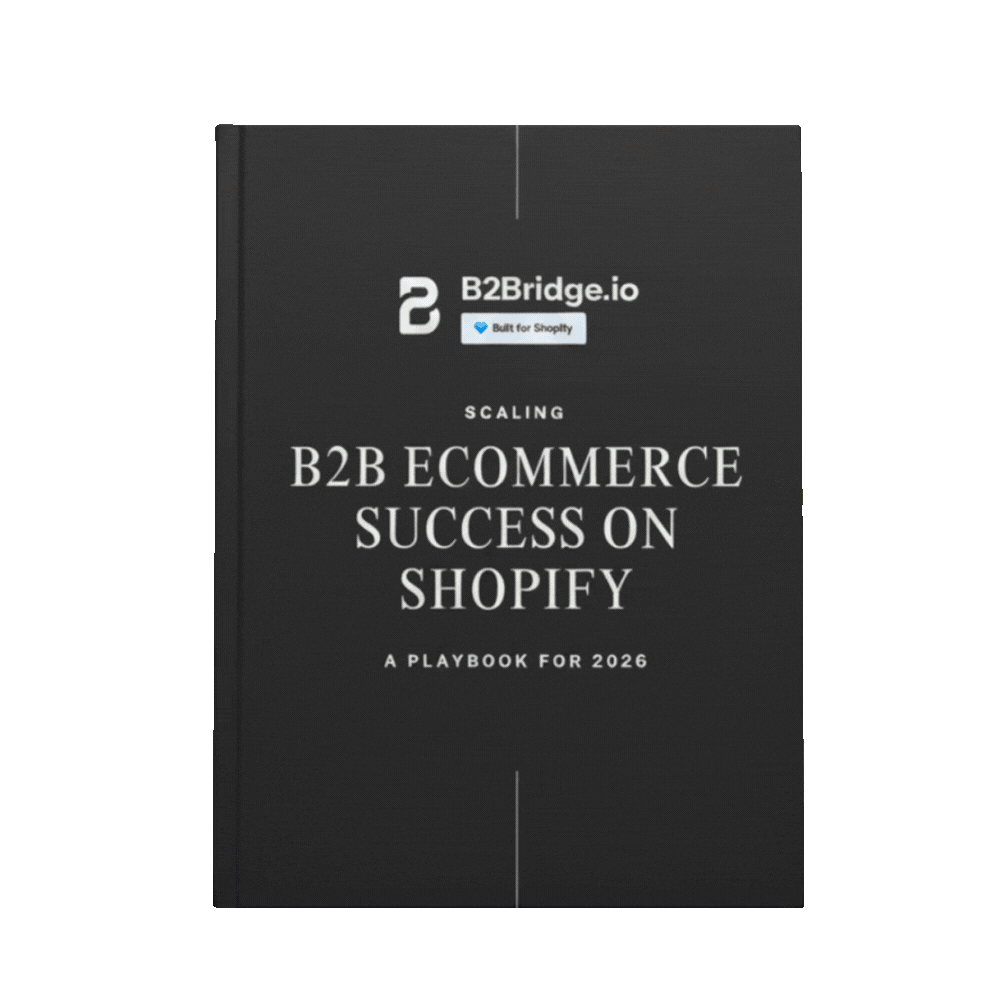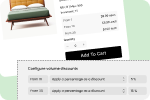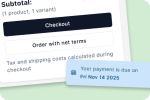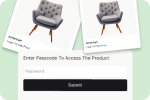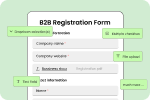Your Shopify store is thriving in the B2C space, and now you’re ready to tap into the lucrative B2B market. Smart move – B2B Ecommerce sales are projected to reach $3 trillion in the US alone by 2027, and wholesale channels consistently deliver higher average order values and customer lifetime value than retail.
But here’s what many merchants discover too late: integrating a B2B Ecommerce solution on Shopify isn’t simply a matter of flipping a switch. While apps like B2Bridge make the technical integration straightforward, the real success factors lie in planning, team alignment, and strategic decision-making before, during, and after implementation.
We’ve worked with hundreds of Shopify merchants transitioning to B2B, and we’ve seen both smooth rollouts and painful struggles. The difference? Merchants who succeed think holistically about integration – considering not just technology, but people, processes, and customer relationships.
In this comprehensive guide, we’ll walk through eight critical considerations that will determine whether your B2B Shopify integration becomes a growth engine or a source of ongoing headaches. Whether you’re implementing B2Bridge or evaluating your options, these insights will help you avoid common pitfalls and set your wholesale channel up for long-term success.
1. Build Your Project Team and Secure Stakeholder Buy-In
Why Team Engagement Matters
The biggest mistake merchants make? Treating B2B integration as purely an IT or Ecommerce project. In reality, a successful B2B Shopify solution touches every department in your organization – sales, customer service, operations, finance, and marketing all play critical roles.

Before you install any apps or configure settings, assemble a cross-functional project team that includes:
- Operations lead: Someone who understands your current order fulfillment and inventory management processes
- Sales representative: A team member who regularly interacts with wholesale customers and understands their needs
- Finance stakeholder: Someone who can address payment terms, credit limits, and accounting integration requirements
- Customer service representative: A frontline staff member who will support B2B customers post-launch
- Technical lead: Your Shopify admin or developer who will handle the actual implementation
Getting Early Buy-In
Involve these stakeholders from day one, not after decisions are made. Early engagement accomplishes several goals:
- Surfaces requirements you might miss: The sales team knows that customers need net 30 payment terms, while operations knows certain products can’t be sold in quantities less than a case
- Reduces resistance to change: People support what they help create; involving team members in planning increases adoption
- Identifies process improvements: Your team may spot inefficiencies in current workflows that B2B integration could solve
- Ensures smooth training: Team members who helped design the system can train their colleagues more effectively
Even if you’re a small operation without dedicated departments, make sure anyone who will interact with the B2B system has input during planning. Their insights are invaluable.

Agency Support vs. Self-Service
Not every business has the internal resources for an extensive project team. B2Bridge offers excellent self-service implementation with comprehensive support documentation and responsive customer success teams. However, if you’re dealing with complex requirements or integrations, partnering with a Shopify Plus agency can accelerate your timeline and ensure best practices are followed.
Consider agency support if you:
- Have extensive customization requirements
- Need integration with complex ERP or accounting systems
- Lack internal technical resources
- Want to launch quickly with minimal trial and error
2. Audit Your Existing Integrations and Tech Stack
Understanding Your Technology Ecosystem
Your Shopify store doesn’t operate in isolation. Before integrating a B2B Ecommerce solution, map out every system that touches your commerce operations:
- ERP systems: NetSuite, Microsoft Dynamics, SAP, or Sage for inventory and order management
- Accounting software: QuickBooks, Xero, or FreshBooks for financial records
- 3PL providers: ShipBob, ShipStation, or custom fulfillment partners for warehousing and shipping
- Email marketing platforms: Klaviyo, Mailchimp, or HubSpot for customer communications
- CRM systems: Salesforce, HubSpot, or Pipedrive for customer relationship management
- Payment processors: Beyond Shopify Payments – any special payment gateways for wholesale transactions
B2Bridge’s Public API simplifies B2B Ecommerce operations by offering secure, flexible access to essential data such as customer groups and price lists. It enables merchants to automate workflows, connect with existing systems, and deliver tailored pricing experiences effortlessly.
Transform your B2B store with B2Bridge.
Discover how B2Bridge can transform your wholesale business.
Schedule a demo today to see our payment management tools in action.
3. Document and Evaluate Current B2B Processes
The Process Audit
How do your wholesale customers order from you today? Many established B2B businesses rely on surprisingly manual processes:
- Phone orders: Sales reps take orders by phone and enter them manually
- Email orders: Customers send order lists via email that staff process individually
- Fax orders: Yes, some industries still use fax machines
- In-person sales: Field sales representatives take orders during customer visits
- EDI systems: Electronic Data Interchange for large enterprise customers
Decide What to Digitize
Don’t assume everything should move to your B2B Shopify platform. For each current process, ask:
Should this be digitized? Some processes work well as-is, especially for high-touch VIP accounts who value personal service.
Can this be digitized effectively? Certain workflows might be too complex or variable for standard Ecommerce functionality.
Will customers adopt the digital version? If your customers are comfortable with current processes and resistant to change, forced digitization might damage relationships.
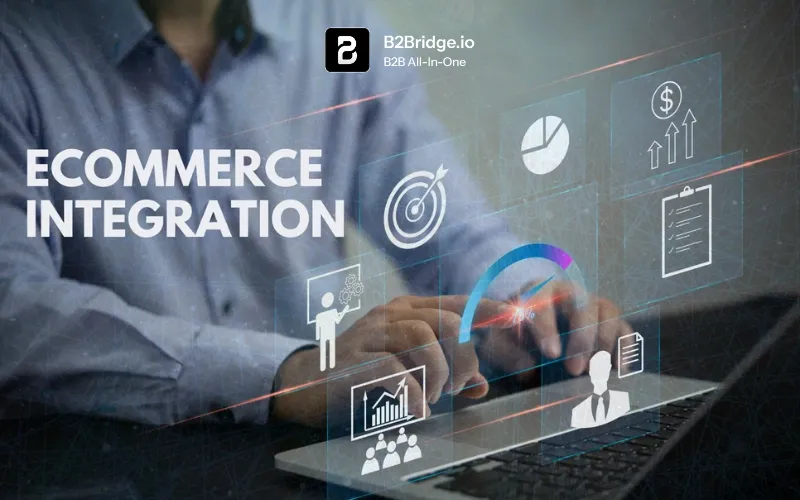
The Hybrid Approach
Many successful B2B Shopify implementations maintain multiple ordering channels:
- Self-service portal (B2Bridge) for standard reorders and straightforward purchases
- Assisted ordering where sales reps use B2Bridge’s manual orders feature to place orders on behalf of customers
- Phone/email backup for complex situations, custom orders, or customer preference
This hybrid model provides flexibility while still capturing the efficiency gains of digital ordering for most transactions.
Account Registration Workflows
Pay special attention to how new wholesale customers get approved and onboarded. Consider:
- Will you accept online applications through your B2Bridge-powered store?
- What information do you need? (business license, tax ID, trade references)
- Who reviews and approves new accounts?
- How quickly must you process applications? (same-day approval vs. 3-5 business days)
- Should certain customer types receive automatic approval?
B2Bridge offers flexible customer approval workflows through B2B registration form that can adapt to your specific requirements, from fully automated to completely manual review. -> Get a free live demo
4. Optimize Your CRM for B2B Customer Management
CRM: The Often-Overlooked Integration
Many Shopify merchants focus on ERP and accounting integrations while treating CRM as an afterthought. This is a mistake. Your B2B customers require different communication strategies than retail shoppers, and effective CRM integration is crucial.
B2B Communication Requirements
Wholesale customers need:
- Personalized outreach: High-value accounts expect account management touchpoints, not just automated marketing emails
- Segmented messaging: Different customer tiers (distributors, retailers, enterprise accounts) require tailored communications
- Educational content: B2B buyers need product training, usage guides, and industry insights
- Order-related communications: Proactive updates about order status, shipping delays, or inventory availability
- Renewal reminders: For subscription or recurring order relationships
Native Integration Opportunities
Popular CRM platforms offer native Shopify integrations:
HubSpot: Comprehensive B2B CRM with marketing automation, available as a Shopify app Klaviyo: Advanced segmentation for B2B vs. B2C customers, triggered flows based on order behavior
Salesforce: Enterprise-grade customer management with bidirectional data sync
B2Bridge customer data syncs with Shopify, which means these CRM platforms can access wholesale customer information, order history, and behavioral data for personalization.

Serving Dual Audiences
If your Shopify store serves both B2C and B2B customers (which is common), your CRM segmentation becomes even more critical. You must:
- Tag and segment B2B customers separately from retail shoppers
- Create distinct email flows that respect each audience’s preferences
- Avoid sending wholesale-focused content to retail customers (and vice versa)
- Measure engagement metrics separately for each channel
Account Management at Scale
For B2B operations with hundreds or thousands of wholesale accounts, manual relationship management becomes impossible. Your CRM should enable:
- Automated check-ins for accounts that haven’t ordered recently
- Alerts when high-value customers show declining purchase patterns
- Task assignment for account managers to follow up with specific accounts
- Tracking of customer health scores based on order frequency, AOV, and engagement
5. Establish Financial Controls and Credit Management
Why Finance Must Be Involved Early
B2B transactions have fundamentally different financial requirements than B2C. Consumers pay immediately with credit cards; wholesale customers often expect net payment terms, purchase orders, and credit limits. These requirements must be architected into your B2B Shopify solution from the start.
Critical Financial Considerations
Work with your finance team to define:
Credit policies: Which customers qualify for net terms? What credit limits will you extend? How will you assess creditworthiness?
Payment methods: Credit cards, ACH transfers, wire transfers, purchase orders, or a combination? What fees will you charge (or absorb) for each method?
Approval workflows: Do large orders require manager approval before processing? At what threshold?
Tax handling: How will you manage sales tax, VAT, or other tax requirements for wholesale transactions across different jurisdictions?
Currency considerations: For international B2B customers, will you accept multiple currencies? How will you handle exchange rates?
Configuring B2Bridge for Financial Requirements
B2Bridge supports sophisticated financial controls:
- Customer-specific payment terms: Assign net 30, net 60, or other terms to individual accounts
- Credit limit enforcement: Set maximum credit limits that prevent orders exceeding approved amounts
- Payment method restrictions: Control which payment options are available to each customer segment
- Order approval workflows: Require manual review for orders over certain values
- Tax exemption handling: Support for wholesale customers with valid tax-exempt certificates
Managing Risk
B2B credit extended to wholesale customers represents real financial risk. Establish processes for:
- Credit checks: Obtain credit reports for new wholesale applicants before extending terms
- Periodic reviews: Re-evaluate credit limits annually or when customer circumstances change
- Collections procedures: Define what happens when invoices go past due
- Account holds: Ability to suspend ordering privileges for accounts with outstanding balances
Don’t launch your B2B channel without clear financial policies and the technical controls to enforce them.
6. Communicate Proactively with Existing Wholesale Customers
The Change Management Challenge
If you already have wholesale customers ordering through traditional channels (phone, email, sales reps), launching a B2B Shopify platform represents significant change. Many long-standing customers will be comfortable with current processes and skeptical about digital transformation.

Poor communication during this transition can damage valuable relationships. Customers might feel:
- Confused about why you’re changing systems
- Concerned that you’re deprioritizing their accounts
- Frustrated about learning new technology
- Worried about losing their established contact with sales reps
The Communication Timeline
Start communicating early and often. Consider this timeline:
3 months before launch: Announce the coming change. Emphasize benefits for customers (24/7 ordering, faster service, better order tracking) without dwelling on technical details.
2 months before launch: Share preview screenshots and videos. Explain what will change and what will stay the same. Address common concerns proactively.
1 month before launch: Offer early access to select VIP customers. Gather feedback and refine the platform before general availability.
Launch week: Provide detailed training resources – video tutorials, step-by-step guides, and live webinar sessions. Make support easily accessible.
Post-launch: Send regular check-ins to ensure customers are successfully using the new system. Celebrate wins and address problems quickly.
Segmented Communication Strategies
Not all wholesale customers need the same messaging:
High-value accounts: Offer white-glove onboarding with personal training sessions from account managers. These relationships deserve individualized attention.
Tech-savvy customers: Provide comprehensive self-service resources. These customers prefer independent exploration with documentation available when needed.
Traditionalists: Reassure them that phone and email ordering remains available during transition. Give them extra time and patience to adopt digital ordering.
Frequent buyers: Emphasize time-saving features like quick reorder and saved shopping lists. Show them how the platform will make their lives easier.
B2Bridge includes manual orders that lets your team place orders on behalf of customers. -> Get a free live demo
7. Choose Your Integration Timing Strategically
When to Launch (and When Not To)
Timing can make or break your B2B Shopify integration. Launch at the wrong moment, and you’ll face unnecessary complications. Choose wisely, and you’ll maximize adoption while minimizing disruption.
Avoid Peak Seasons
Never launch during your busiest periods. If you’re in retail, don’t go live in November or December. If you serve schools, avoid back-to-school season. If you’re in hospitality, skip major holiday periods.
During high-volume periods:
- Your team is stretched thin and can’t provide adequate support
- Customers are stressed and resistant to learning new systems
- Technical issues have magnified impact on revenue
- You can’t afford the trial-and-error period that all new systems require
Consider Your Customers’ Calendars
Your wholesale customers have their own peak seasons, which might differ from yours. Distributors may have specific ordering cycles tied to trade shows or seasonal inventory builds. Retailers have their own busy periods.
Survey your customer base about timing preferences. You might discover that:
- January is slow for everyone and ideal for learning new systems
- Mid-summer provides a natural lull for training and adoption
- Quarterly planning cycles make certain months better than others
Build in Soft Launch Time
Don’t announce a grand opening on day one. Instead:
Week 1-2: Soft launch with internal testing only. Your team uses the production system to identify issues.
Week 3-4: Beta launch with 10-20 friendly customers who volunteer to test. Gather feedback and fix problems.
Week 5-6: Expanded access to your top 20% of customers. Monitor closely and refine.
Week 7+: General availability for all wholesale customers with confidence that major issues are resolved.
This staged rollout reduces risk and ensures you’re not troubleshooting major problems with your entire customer base at once.
Align with Other Initiatives
Consider how B2B Shopify integration timing aligns with:
- Website redesigns or replatforming projects
- ERP system implementations or upgrades
- New warehouse or fulfillment center openings
- Major marketing campaigns or product launches
Too many simultaneous changes create complexity. Space out major initiatives when possible, or deliberately bundle related changes together to consolidate the transition period.
8. Accept Complexity and Be Ready to Compromise
The Perfect System Doesn’t Exist
Here’s an uncomfortable truth: you cannot automate every B2B process perfectly. Every business has unique workflows, exceptional cases, and legacy requirements that don’t fit neatly into any platform’s standard functionality – even one as flexible as B2Bridge.
Merchants who struggle with B2B integration often share a common trait: they refuse to compromise. They insist that the system must exactly replicate their current processes, automating every nuance and edge case.
This perfectionism leads to:
- Delayed launches while waiting for custom development
- Bloated systems with excessive complexity
- Poor user experience from trying to accommodate every scenario
- Ongoing maintenance headaches as edge cases multiply
Strategic Compromise
Successful implementations require pragmatic compromise. The goal isn’t perfection – it’s meaningful improvement over the status quo.
Identifying What Matters Most
Categorize your B2B requirements:
Critical must-haves: Core functionality required for basic operations (customer-specific pricing, order management, inventory sync). Don’t compromise here.
Important features: Capabilities that significantly improve efficiency but have workarounds if absent (quick reorder, bulk import, advanced reporting). Implement these when possible.
Nice-to-haves: Bells and whistles that are convenient but not essential (custom dashboard widgets, specialized reports, aesthetic preferences). Don’t delay launch for these.
Edge cases: Rare scenarios affecting less than 5% of transactions (unusual payment arrangements, exceptional order types). Handle these manually outside the system.
Examples of Smart Compromise
Credit checks: Rather than building automated credit checking into your B2B Ecommerce platform, manually assess new wholesale applicants before granting access. Use B2Bridge’s approval workflows to flag new accounts, then conduct credit checks offline. Once approved, tag customers appropriately for their payment terms.
Custom pricing exceptions: Instead of programming every pricing special case, establish standard tiers in B2Bridge (gold, silver, bronze) and handle one-off exceptions through manual quotes or adjustments.
Complex bundling: If you have thousands of possible product combinations with interdependent pricing, don’t try to automate it all. Create standard bundles in B2Bridge for common scenarios and handle custom configurations through assisted ordering.
Legacy customer data: Rather than spending months cleaning and importing decades of messy customer data, start fresh with clean B2Bridge customer records and maintain legacy data in read-only format for reference.
Maintaining Manual Processes
Some workflows genuinely work better outside your B2B platform:
- Highly customized orders that require extensive consultation
- Complex RFQ processes involving multiple stakeholders and revisions
- Special terms negotiated with enterprise accounts
- Returns and credits requiring approval and documentation
It’s okay to handle these manually. The goal is to automate what you can efficiently while maintaining flexibility for exceptions.
Continuous Improvement
Launch with your core requirements met and a roadmap for enhancement. B2Bridge regularly releases new features, and Shopify’s ecosystem continuously evolves. What’s impossible today might be standard functionality next quarter.
Better to launch at 80% perfection and improve iteratively than to delay indefinitely pursuing 100%.
Planning for Long-Term Success
Beyond Implementation
The considerations we’ve outlined ensure successful initial integration, but B2B Ecommerce is an ongoing journey, not a one-time project.
Post-Launch Optimization
After your B2B Shopify solution is live, continue investing in:
User feedback: Regularly survey wholesale customers about their experience. What’s working? What’s frustrating? What features would they value?
Analytics review: Monitor which features get used, where customers struggle, and what drives conversions. Use data to prioritize improvements.
Staff training refreshers: As your team gains experience, they’ll discover better ways to use B2Bridge features. Share these best practices across the organization.
Process refinement: Your initial processes won’t be optimal. Continuously evaluate and adjust based on real-world results.
Scaling Considerations
As your B2B channel grows, your requirements will evolve:
- More customer segments requiring distinct experiences
- International expansion adding complexity
- Increased order volume requiring automation
- Integration with additional business systems
- Advanced reporting and analytics needs
B2Bridge scales with your business, but planning for growth from the beginning makes expansion smoother.
Conclusion
Integrating a B2B Ecommerce solution on Shopify represents a significant opportunity to modernize your wholesale channel, increase efficiency, and scale your business. By addressing these eight critical considerations, you’ll avoid common pitfalls and position your B2B channel for sustainable growth. The wholesale market is massive and growing, and B2B Ecommerce solutions on Shopify provide an accessible, powerful way to capture that opportunity.
Whether you’re just beginning to explore B2B options or you’re ready to implement, taking time to plan properly will pay dividends for years to come.
Ready to Launch Your B2B Shopify Channel?
B2Bridge makes B2B Ecommerce integration straightforward with powerful features built specifically for wholesale. Our B2B Shopify app handles custom pricing, customer segmentation, bulk ordering, quote management, and all the complexities of B2B commerce while integrating seamlessly with your existing Shopify store.
From initial planning through launch and beyond, our team supports you at every stage. We’ve helped hundreds of Shopify merchants successfully transition to B2B, and we’ve learned what works – and what doesn’t.
Schedule A Demo | View B2Bridge Features | Read Success Stories
Have questions about your specific B2B integration requirements? Our Ecommerce specialists can assess your needs and recommend the best approach. Contact us to discuss how B2Bridge can support your wholesale growth objectives.
Hi, I’m Ha My Phan – an ever-curious digital marketer crafting growth strategies for Shopify apps since 2018. I blend language, logic, and user insight to make things convert. Strategy is my second nature. Learning is my habit. And building things that actually work for people? That’s my favorite kind of win.
